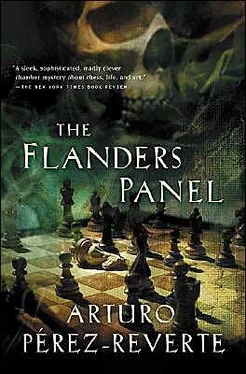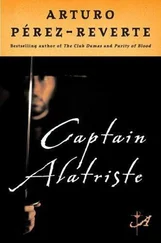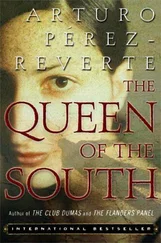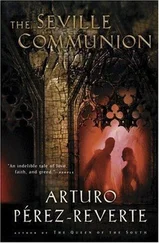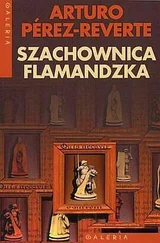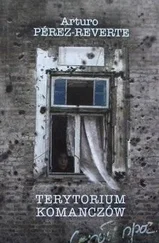State of preservation of surface film: No apparent traces of salt exudation or damp. Excessive darkening of the varnish due to oxidation; varnish removal and new varnish advisable.
The coffeepot was bubbling in the kitchen. Julia got up and poured herself a large cup, black, no sugar. She returned with the cup in one hand, drying the other on the baggy man-size sweater she was wearing over her pyjamas. A light touch of her index finger and the sounds of Vivaldi’s Concerto for lute and viola d’amore burst upon the room, gliding on the grey morning light. She took a sip of thick, bitter coffee that burned the tip of her tongue. Then she sat down again, her feet bare on the carpet, and continued typing the report.
UV and X-ray examination: Detected no obvious major changes, alterations or subsequent repaints. The X-rays reveal a concealed inscription of the period, in Gothic lettering (see enclosed prints). This is not visible using conventional methods of examination. It could be uncovered without damage to the original by removing the layer of paint now covering the area.
She removed the sheet of paper from the typewriter and put it in an envelope with the X-ray photos, drank the rest of the coffee, which was still hot, and settled down to smoke another cigarette. Before her on the easel, in front of the lady by the window absorbed in her reading, the two chess players were engaged in a game that had been going on now for five centuries, a game depicted by Pieter Van Huys with such rigour and mastery that, like all the other objects in the picture, the chess pieces seemed to stand out in relief from the surface. The sense of realism was so intense that the painting effortlessly achieved the effect sought by the old Flemish masters: the integration of the spectator into the pictorial whole, persuading him that the space in which he stood was the same as that represented in the painting, as if the picture were a fragment of reality, or reality a fragment of the picture. Adding to this effect were the window on the right-hand side of the composition, showing a landscape beyond the central scene, and a round, convex mirror on the wall to the left, reflecting the foreshortened figures of the players and the chessboard, distorted according to the perspective of the spectator, who would be standing facing the scene. It thus achieved the astonishing feat of integrating three planes – window, room and mirror – into one space. It was, thought Julia, as if the spectator were reflected between the two players, inside the painting.
She went over to the easel. Arms folded, she stood looking at the painting for a long time, utterly still, apart from drawing occasionally on her cigarette and screwing up her eyes against the smoke. One of the chess players, the one on the left, looked to be about thirty-five. His brown hair was shaved just above the ears in the medieval fashion; he had a strong, aquiline nose and a look of intense concentration. He was wearing a doublet painted in a vermilion that had admirably withstood both the passage of time and the oxidation of the varnish. Round his neck he wore the insigne of the Golden Fleece and near his right shoulder an exquisite brooch, whose filigree pattern was rendered in minute detail, right down to the tiny gleam of light on each precious stone. He was sitting with his left elbow and right hand resting on the table on either side of the board. Between the fingers of his right hand he was holding one of the chess pieces: a white knight. By his head there was an identifying inscription in Gothic lettering: FERDINANDUS OST. D.
The other player was thinner and about forty. He had a smooth forehead and almost black hair turning to grey at the temples, where the finest of white lead brush marks were just distinguishable. This, together with his expression and general air of composure, gave him a look of precocious maturity. His profile was serene and dignified. Unlike the other player, he was dressed not in sumptuous court clothes, but in a simple leather cuirass, with a gorget of burnished steel that gave him an unmistakably military air. He was leaning further over the chessboard than his opponent, as if concentrating hard on the game, apparently oblivious to his surroundings, his arms folded on the edge of the table. His concentration could be seen in the faint, vertical lines between his eyebrows. He was looking at the pieces as if they were confronting him with a particularly difficult problem whose solution required every ounce of intellectual energy. The inscription above his head read: RUTGIER AR. PREUX.
The lady sitting next to the window was set apart from the two players by the use of a sharp linear perspective that situated her on a higher plane within the picture. The black velvet of her dress, to which the skilled application of white and grey glazes added volume, seemed to come out of the painting towards you. Its realism rivalled even the painstaking detail of the carpet border, the precision in the painting of the tiled floor, every knot, joint and grain of the ceiling beams. Leaning towards the painting to study these effects more closely, Julia felt a shiver of professional admiration run through her. Only a master like Van Huys could have used the black of a gown to such advantage, employing colour created out of the absence of colour to an extent few would have dared. Yet it was so real that Julia felt that at any moment she would hear the soft swish of velvet on the embossed leather of the low stool.
She looked at the woman’s face. It was beautiful and, in the fashion of the time, extremely pale. Her thick blonde hair, carefully smoothed back from her temples, was caught up beneath a toque of white gauze. Her arms, sheathed in light grey damask, emerged from loose sleeves; her hands, long and slender, held a book of hours. The light from the window picked out the same metallic gleam on the open clasp of the book and on the single gold ring adorning her hand. Her eyelids were lowered, over what had to be blue eyes, in an expression of serene and modest virtue characteristic of female portraits of the period. The light came from two sources, the window and the mirror, at once connecting the woman with the two chess players and keeping her subtly separate, her figure more marked by foreshortening and shadows. Her inscription read: BEATRIZ BURG. OST. D.
Julia took a couple of steps back to view the painting as a whole. There was no doubt about it: it was a masterpiece, with documentation accredited by experts. That would mean a high price at the auction to be held by Claymore’s in January. Perhaps the hidden inscription, together with the appropriate historical documentation, would increase the value of the painting. Ten per cent for Claymore’s, five per cent for Menchu Roch, the rest for the owner. Less one per cent for insurance and her fee for restoring and cleaning it.
She took off her clothes and stepped into the shower, leaving the door open, so that Vivaldi’s music could keep her company in the steam. Restoring The Game of Chess for its entry into the art market could bring her a sizeable amount. Within only a few years of finishing her degree, Julia had won for herself a solid reputation and become one of the art restorers most sought after by museums and antiquarians. Methodical and disciplined, a painter of some talent in her spare time, she was known for the respect she showed the original work, an ethical position not always shared by her colleagues. In the difficult and often awkward spiritual relationship between any restorer and his or her job, in the bitter controversy between conservation and renovation, the young woman had the virtue of never losing sight of one fundamental principle: no work of art could ever be restored to its primitive state without sustaining serious damage. Julia believed that things like the ageing process, the patina, the way colours and varnishes changed, even flaws, repainting and retouching, became, with the passing of time, as integral a part of a work of art as the original work. Perhaps because of that, the paintings that passed through her hands never left them decked out in strange new, supposedly original colours and lights – “painted courtesans”, Cesar called them – but were treated with a delicacy that integrated the marks of time with the work.
Читать дальше
